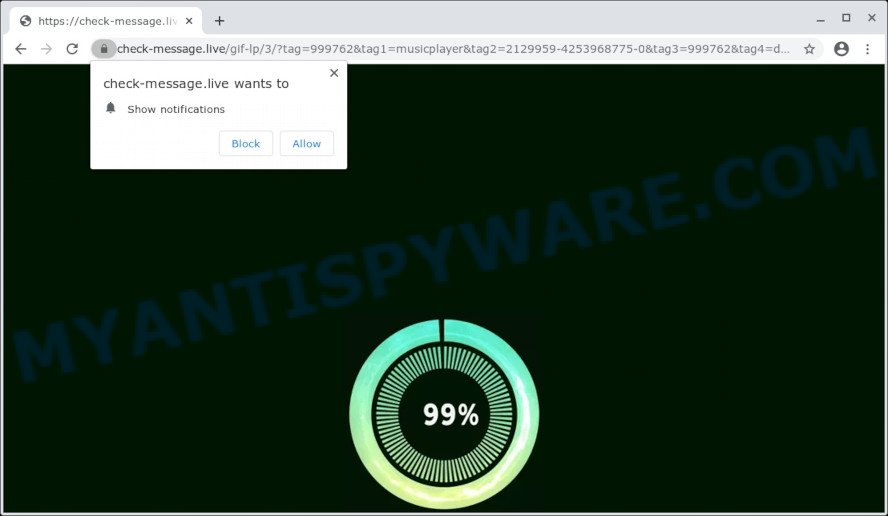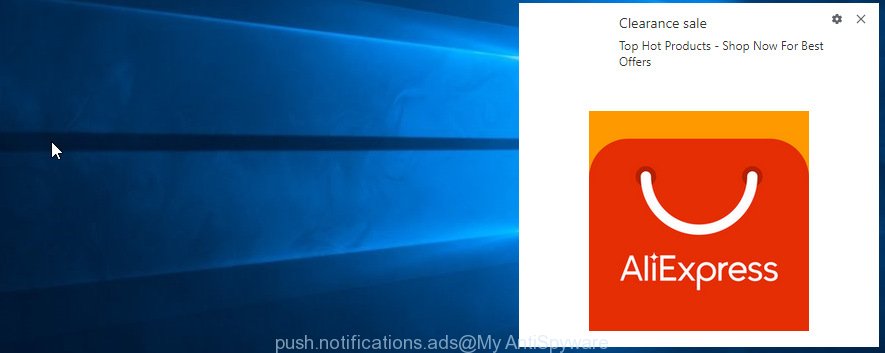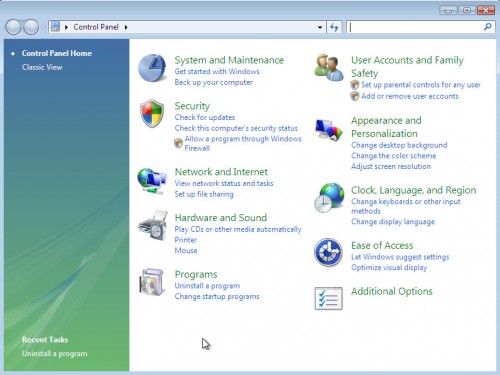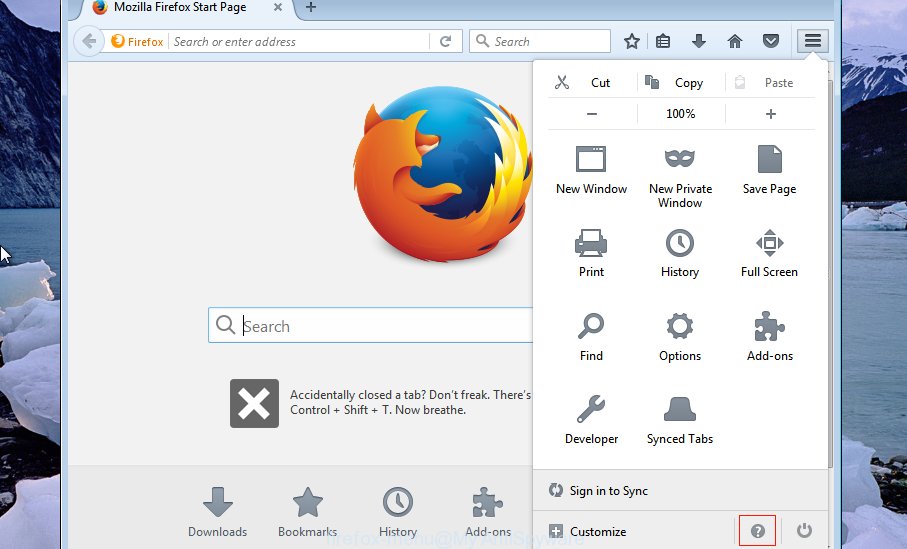File-upload.com is a website that is advertised as a service that allows users to store files online. While this website is legitimate and harmless, security experts warn that caution should be exercised when using it. The security researchers have found that ads on this site can redirect users to web pages that are not trustworthy, as they are designed to deceive users. Moreover, some websites to which users can be redirected are used to advertise potentially unwanted programs (PUPs), force the user to install malicious browser extensions or subscribe to spam notifications.

During the research, File-upload.com redirected users to check-message.live, other unwanted and suspicious sites.
File-upload.com opens check-message.live:

File-upload.com opens other unwanted and suspicious sites:

File-upload.com will display the ‘Show notifications’ prompt that attempts to get the user to click the ‘Allow’ button to subscribe to its notifications. If you click the ‘Allow’, then you will start seeing unwanted adverts in form of popup windows on the desktop. The makers of File-upload.com use these push notifications to bypass popup blocker and therefore display lots of unwanted ads. These ads are used to promote questionable web browser add-ons, giveaway scams, adware bundles, and adult web-pages.

File-upload.com can redirect users to other dangerous sites, among which there may be sites offering to install PUPs, browser hijackers and adware. Browser hijacker is a malware that changes browser settings such as homepage and search engine. Adware is something that you should be aware of even if you use Google Chrome or other modern browser. This is the name given to apps that have been designed to show annoying advertisements and pop-up deals onto your browser screen. The reason for adware’s existence is to generate revenue for its author.
In most cases, adware gets onto PC system by being attached to the setup packages from file sharing websites. So, install a free software is a a good chance that you will find a bundled adware. If you don’t know how to avoid it, then use a simple trick. During the setup, choose the Custom or Advanced install option. Next, click ‘Decline’ button and clear all checkboxes on offers that ask you to install bundled applications. Moreover, please carefully read Term of use and User agreement before installing any applications or otherwise you can end up with another unwanted program on your device such as this adware.
How to remove File-upload.com pop-up ads and notifications
If you’ve allowed the File-upload.com site to send push notifications to your web-browser, then we will need to delete these permissions. Depending on internet browser, you can use the following steps to delete the File-upload.com permissions to send push notifications.
|
|
|
|
|
|
How to remove Adware and stop unwanted ads
Adware software is a form of malware that you might have difficulty in uninstalling it from your personal computer. Happily, you’ve found the effective adware removal steps in this article. Both the manual removal way and the automatic removal way will be provided below and you can just select the one that best for you. If you’ve any questions or need help then type a comment below. Read it once, after doing so, please bookmark this page (or open it on your smartphone) as you may need to shut down your internet browser or restart your PC system.
To remove unwanted ads, perform the following steps:
How to manually get rid of unwanted ads
In this section of the blog post, we have posted the steps that will help to remove unwanted advertisements manually. Although compared to removal utilities, this solution loses in time, but you don’t need to install anything on the computer. It will be enough for you to follow the detailed instructions with pictures. We tried to describe each step in detail, but if you realized that you might not be able to figure it out, or simply do not want to change the Windows and web browser settings, then it’s better for you to use tools from trusted developers, which are listed below.
Uninstall newly installed adware
First, you should try to identify and uninstall the program that causes the appearance of unwanted advertisements or web browser redirects, using the ‘Uninstall a program’ which is located in the ‘Control panel’.
Press Windows button ![]() , then click Search
, then click Search ![]() . Type “Control panel”and press Enter. If you using Windows XP or Windows 7, then press “Start” and select “Control Panel”. It will show the Windows Control Panel as on the image below.
. Type “Control panel”and press Enter. If you using Windows XP or Windows 7, then press “Start” and select “Control Panel”. It will show the Windows Control Panel as on the image below.

Further, press “Uninstall a program” ![]()
It will display a list of all programs installed on your computer. Scroll through the all list, and remove any suspicious and unknown software.
Get rid of unwanted ads from Firefox by resetting internet browser settings
The Firefox reset will get rid of unwanted ads, modified preferences, extensions and security settings. When using the reset feature, your personal information such as passwords, bookmarks, browsing history and web form auto-fill data will be saved.
Click the Menu button (looks like three horizontal lines), and press the blue Help icon located at the bottom of the drop down menu like below.

A small menu will appear, click the “Troubleshooting Information”. On this page, click “Refresh Firefox” button similar to the one below.

Follow the onscreen procedure to return your Mozilla Firefox internet browser settings to their default state.
Get rid of unwanted ads from Internet Explorer
The IE reset is great if your web-browser is hijacked or you have unwanted add-ons or toolbars on your web-browser, which installed by an malware.
First, run the IE, then click ‘gear’ icon ![]() . It will show the Tools drop-down menu on the right part of the internet browser, then press the “Internet Options” as on the image below.
. It will show the Tools drop-down menu on the right part of the internet browser, then press the “Internet Options” as on the image below.

In the “Internet Options” screen, select the “Advanced” tab, then click the “Reset” button. The Microsoft Internet Explorer will show the “Reset Internet Explorer settings” prompt. Further, press the “Delete personal settings” check box to select it. Next, click the “Reset” button as shown in the following example.

After the process is done, click “Close” button. Close the IE and reboot your computer for the changes to take effect. This step will help you to restore your browser’s newtab page, homepage and search provider by default to default state.
Remove unwanted ads from Chrome
Reset Chrome settings will help you to completely reset your browser. The result of activating this function will bring Chrome settings back to its default state. This can remove unwanted ads and disable malicious extensions. It will save your personal information such as saved passwords, bookmarks, auto-fill data and open tabs.

- First start the Chrome and click Menu button (small button in the form of three dots).
- It will open the Google Chrome main menu. Select More Tools, then click Extensions.
- You will see the list of installed extensions. If the list has the extension labeled with “Installed by enterprise policy” or “Installed by your administrator”, then complete the following guidance: Remove Chrome extensions installed by enterprise policy.
- Now open the Google Chrome menu once again, click the “Settings” menu.
- You will see the Chrome’s settings page. Scroll down and press “Advanced” link.
- Scroll down again and press the “Reset” button.
- The Google Chrome will display the reset profile settings page as shown on the image above.
- Next press the “Reset” button.
- Once this procedure is finished, your web-browser’s newtab, homepage and default search provider will be restored to their original defaults.
- To learn more, read the article How to reset Google Chrome settings to default.
Automatic Removal of adware
Spyware, adware, PUPs and browser hijackers can be difficult to remove manually. Do not try to remove this programs without the aid of malicious software removal utilities. In order to fully delete adware software from your PC, run professionally created tools, like Zemana, MalwareBytes Anti-Malware (MBAM) and HitmanPro.
How to remove adware with Zemana Anti Malware (ZAM)
Zemana Free is a malware scanner that is very effective for detecting and removing adware. The steps below will explain how to download, install, and use Zemana Anti-Malware to scan and remove malware, spyware, adware, PUPs, browser hijackers from your computer for free.
Please go to the link below to download Zemana Free. Save it to your Desktop.
165036 downloads
Author: Zemana Ltd
Category: Security tools
Update: July 16, 2019
After the downloading process is complete, run it and follow the prompts. Once installed, the Zemana will try to update itself and when this process is done, click the “Scan” button to perform a system scan for the adware that causes unwanted ads.

A scan can take anywhere from 10 to 30 minutes, depending on the number of files on your personal computer and the speed of your PC. When a malware, adware or PUPs are found, the count of the security threats will change accordingly. Review the report and then press “Next” button.

The Zemana Anti-Malware (ZAM) will start to remove adware.
How to stop unwanted ads
If you surf the Internet, you cannot avoid malicious advertising. But you can protect your browser against it. Download and use an ad-blocker application. AdGuard is an ad-blocking that can filter out lots of of the malvertising, blocking dynamic scripts from loading malicious content.
AdGuard can be downloaded from the following link. Save it to your Desktop.
26898 downloads
Version: 6.4
Author: © Adguard
Category: Security tools
Update: November 15, 2018
After downloading it, double-click the downloaded file to start it. The “Setup Wizard” window will show up on the computer screen as shown in the figure below.

Follow the prompts. AdGuard will then be installed and an icon will be placed on your desktop. A window will show up asking you to confirm that you want to see a quick guide as displayed below.

Click “Skip” button to close the window and use the default settings, or click “Get Started” to see an quick guide which will help you get to know AdGuard better.
Each time, when you run your computer, AdGuard will start automatically and stop unwanted ads, block harmful or misleading web sites. For an overview of all the features of the program, or to change its settings you can simply double-click on the AdGuard icon, that is located on your desktop.
To sum up
Once you’ve done the few simple steps above, your PC should be clean from adware which causes unwanted ads. The Chrome, MS Edge, IE and Firefox will no longer redirect you to malicious and misleading websites. Unfortunately, if the steps does not help you, then you have caught a new adware, and then the best way – ask for help here.

















